Chagres River
|
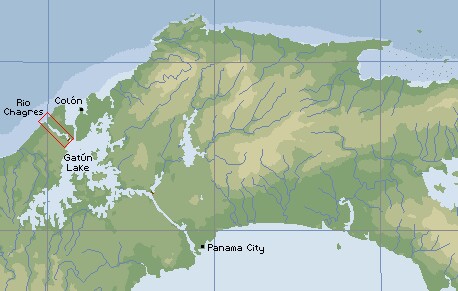 Landscape: Fairly flat land, covered in dense, lush rainforest. Most of the
river was around 100-200 feet (30-60m) across and about 40 feet (12m) deep.
Landscape: Fairly flat land, covered in dense, lush rainforest. Most of the
river was around 100-200 feet (30-60m) across and about 40 feet (12m) deep.
Visited: March 1 - 4, 2003
The Chagres River is 7 miles west of the
Colon entrance to the Panama Canal
|
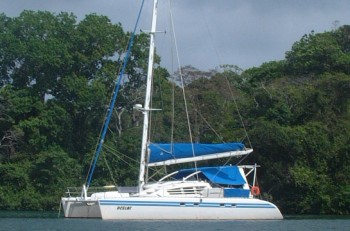
Ocelot anchored in the jungle up the Chagres River |
(Chris age 16) In a way, the
Rio Chagres was the fulfillment of a dream I have had ever since reading about
South American rainforests; to go up a river in a rainforest and explore. We
easily took Ocelot up the river, and anchored with a surprisingly large number
of other boats (about 8 to 10). The area was actually large enough to make a
fair-sized anchorage, and one of the few parts of the river less than thirty
feet deep.
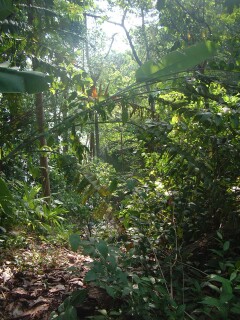
Hiking through Panamanian Jungle! |
The trip up the
river coming in was glorious. We saw parrots, monkeys, and beautiful rainforest
plants. There was a smell of green growth, mixing at times with the scent of
tropical flowers carried on the breeze. Aside from the soft hum of Ocelot's
engines, there was a constant music of bird calls and howler monkeys. Despite
the tall trees surrounding us, there was a cool wind that kept us from feeling
too hot.
Our first full day
after we anchored, we went ashore with a few other boats and tied up to a small
dock. There were several paths leading into the forest, and we took one that
headed in the direction of the canal. The first twenty minutes or so of the
hike, we saw nothing except jungle and the creatures that live in it. Beyond
that, we came to the dam at the head of the Chagres River, which produces
electricity and regulates the level of the Gatun Lake. Past the dam, we arrived
at the Gatun Locks themselves, the first section (Atlantic to Pacific) of the
Panama Canal.
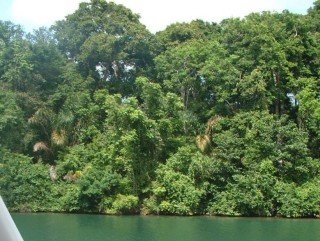
The wild banks of the Chagres River |
Walking in the
tropical rainforest has always been a joy to me. This path, however, was far
beyond what I had ever seen before. Any direction I looked, including straight
up or straight down, I knew I was in the jungle. Looking up, the sky was almost
invisible , and the rainforest canopy stretched easily across the path. On the
ground, insects, mostly ants, worked in the leafy forest floor. There were so
many ants, in fact, that they cleared paths sometimes four or five inches wide,
with constant streams of insects going out to cut leaves or returning with
pieces often bigger than themselves. We also saw hummingbirds, monkeys, and a
few other animals. Vines, flowers, and towering trees were visible wherever we
looked.
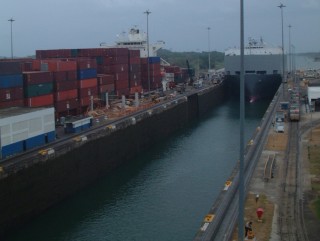
Gatun Locks from the observation platform |
The Chagres River
used to drain out of the Gatun Lake freely, but with the construction of the
Panama Canal, a dam was constructed to regulate the lake and produce
electricity. Because of the dam, it is no longer possible to boat directly into
Gatun Lake from the Chagres River, but the river anchorage was about as close to
the dam as you could get without being able to see it. This meant that we saw
the dam after only a short while walking, and emerged from the forest a little
while later. As we left the forest, we had the option of going to the right, to
see the dam and its power station, or to the left, where we could see huge
freighters being brought along the canal.
We chose to go
left, and began the walk up to the locks. It took at least a half hour of
walking before we could even see the canal clearly, and there was a guarded
fence on this side. The guard told us to go all the way down to the bottom of
the locks, where we could take bridges over to the observation side. We followed
his instructions, which involved more hiking in the hot sun, and went up to a
high observation platform where we could look down on the massive locks as huge
ships moved along them. An English-speaking guide explained about the canal, the
locks, and the ships, while we watched. When it started getting towards
lunchtime, we walked back to the river and Ocelot.
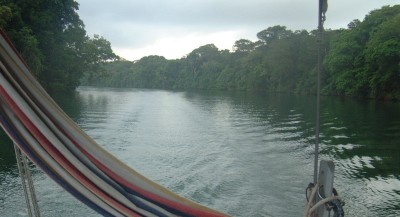
Motoring up the spectacular Chagres River |
(Amanda age 13) Wow, it's sort
of hard to tell you much more than that. I agree, it was wonderful to take
Ocelot up the Chagres, and even more amazing when we took hikes ashore or went
touring in the dinghy. In the morning, we were woken up by the hoots and screeches
of the howler monkeys, and the songs of birds just right there.
On our main walk ashore, out to watch the boats going through the canal, Mom and
I identified two new hummingbirds. One of them was amazingly tame, it let me get
within ten feet of it sitting on a branch and take several pictures.
We were anchored
just behind a little island with one, perhaps two little trees. And let me tell
you, those trees were jam-packed with birds. It made it harder to identify any
one species, however, because color and songs got intermingled. Another cruiser
in the anchorage let us borrow a bird guide to Panama, as we only had the West
Indies and Venezuela, and some of the birds are completely different.
At night, we shone
our huge 1-million-candle-power flashlight around the banks, and saw, just what
we expected to, and the reason we didn't swim in the freshwater - eight or nine
sets of glowing red eyes looking back at us. Yep, crocodiles. Or alligators, I'm
not sure which because we didn't see any during the daylight. I wasn't too
anxious to find out, either.
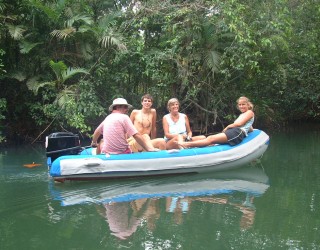
Checking out some of the Chagres tributaries |
(Jon)
It's so much fun to take the family someplace natural that they all love so
much. The entrance to the river was a bit dicey, involving 2 sharp turns
to avoid a reef and stay off the beach, but navigation was easy once we were
in. We just quietly motored 5 miles up the river, soaking in
the variety and beauty of it all. The US Army used to do jungle training
in this area, so apparently it's full of trails, but if you don't want to go
bushwhacking there are also some old railway grades that provide wide, level
trails. One of my favorite parts of the trip was exploring some of the
little side streams by dinghy. We'd go up a stream for a bit, then just
cut the motor and drift, all senses extended to try to capture the rich
intensity of the jungle. At night, talk was usually subdued as the night
jungle sounds came alive to serenade us.
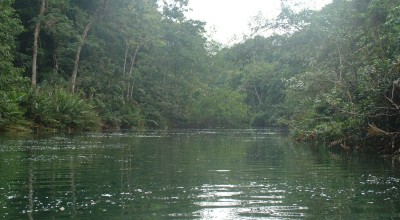
Exploring the glorious Chagres River |
(Sue) Oh gloriosities!
I loved our time up the river. This was the first time we'd taken Ocelot from
the open ocean, across a river-mouth (narrow, with reef on one side, and
breaking sandbank on the other), to enter a world of slow-moving, brackish water
that was over 35 feet deep, about 200 feet wide, bordered by lush, untouched
tropical forest. The bird calls alone were enchanting, but the grunts, roars and
howls of the howler monkeys added a new level of mystery to the experience. Each
morning I awoke to their calls, then set up my birding station in the cockpit --
bird books spread on the table, camera and binoculars at the ready. Each
day the small islet near us was crowned by a yellow-rumped cacique, a
grackle-sized black bird with brilliantly yellow back and rump. Its song varies
from shrill calls to a liquid, watery warble.
Up | Bonaire | Curacao | Passage | San Blas | Portobelo | Chagres River | Canal Transit | Transit Cruising Info
Leeward Islands | Windward Islands | Venezuela | Southwest Caribbean
| Panama Newsletters
| SW Carib Flora/Fauna
Top Level:
Home |
Destinations |
Cruising Info |
Underwater |
Boat Guests |
Ocelot |
Sue |
Jon |
Amanda |
Chris |
Site Map |
Make a Comment
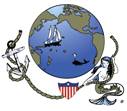 |
Lifetime
Commodores
of the
Seven Seas
Cruising
Association |
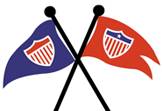 |
|
If our information is useful,
you can help by making a donation
|
Copyright © 2000‑ Contact:
Jon and Sue Hacking -- HackingFamily.com, svOcelot.com.
All rights reserved.
 Landscape: Fairly flat land, covered in dense, lush rainforest. Most of the
river was around 100-200 feet (30-60m) across and about 40 feet (12m) deep.
Landscape: Fairly flat land, covered in dense, lush rainforest. Most of the
river was around 100-200 feet (30-60m) across and about 40 feet (12m) deep.







